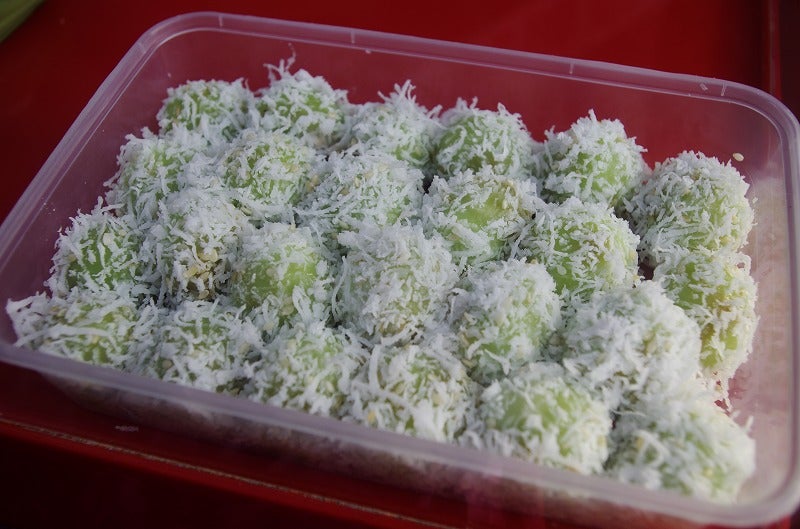Disclaimer: In Real Life is a platform for everyday people to share their experiences and voices. All articles are personal stories and do not necessarily echo In Real Life’s sentiments.
I grew up in a Malay household, and my family lived a modernized lifestyle.
But even so, my mom never failed to instruct and pass down traditions of our Malay ancestry to my brother and me, especially traditional cuisine.
She has learnt most of this traditional cuisine from my late grandma, or as we’ve called her Opah. And Opah was indeed a fabulous cook.
It’s baffling, yet amazing that the taste of mom’s dishes was close to being identical to that of Opah’s.
And with the current Movement Control Order (MCO), I decided to ask my mom to teach me!
Preparing Onde-Onde | 10 – 20 Minutes

Image taken from flickr.com.
This was the first dish that I’ve learnt from my mom. Although I’m a rookie in the kitchen, I find this dish relatively easy to prepare.
The Ingredients:
- 2 cups of glutinous rice flour
- 7 Pandan leaves to be blended
- 100g of palm sugar, finely chopped / grounded / crushed
- 100g of grated coconut
- A pinch of Himalayan rock salt
- 1 teaspoon of Pandan extract (optional)
First, I blended the pandan leaves with water into liquid form. Then I strained the water into a bowl. This is for the purpose of flavour and colour extraction.
In a large bowl, I sifted the glutinous rice flour and poured in the pandan juice. If you have Pandan extract, you can add it here in this step.
I started kneading the dough until it was smooth and non-sticky to the hands.
Next, I broke up the huge chunk of palm sugar and used a mortar and pestle to crush it into smaller chunks.
Meanwhile, I put a pot of water on the boil.
I pinched a small piece of the dough, flattened it and placed a few small lumps of palm sugar in the centre of the dough.
Then, I kneaded it shut and rolled it until it turned into a smooth ball. I did this for the rest of the dough until I had 20 or so balls.
It’s ready to be cooked now!
![5 Traditional Malay Dishes I Learnt — And How They Reconnected Me With My Roots in In Real Life [Ladle the dough balls gently into the hot water to avoid getting scalded.]](https://inreallife.my/wp-content/uploads/2020/04/9.jpg)
[Ladle the dough balls gently into the hot water to avoid getting scalded.]
Back to the pot, the onde-onde could be seen floating around the surface. So, I removed them with a slotted spoon (you can use a strainer) and coated it with the grated coconut. And it’s ready to be served!
Preparing Kuih Ketayap | 10 – 20 Minutes
![5 Traditional Malay Dishes I Learnt — And How They Reconnected Me With My Roots in In Real Life [Kuih Ketayap. Source: Jaz Pereira]](https://inreallife.my/wp-content/uploads/2020/04/8.jpg)
[Kuih Ketayap. Source: Jaz Pereira]
It is the second simplest dish that I’ve learnt after Onde-Onde.
The Ingredients:
Crepe Batter
- 2 cups of wheat flour
- 7 pandan leaves to be blended / 1 teaspoon of pandan extract
- 1 egg
- 2 tablespoons of sugar
- 3 tablespoon of cooking oil
- 1 teaspoon of Himalayan rock salt
Filling
- 100g of gula melaka
- 1 Pandan leaf tied in a knot
- 100g of grated coconut
- ½ cup of water
- 1 tablespoon of sugar
- A pinch of Himalayan rock salt
To prepare the filling, I poured ½ cup of water into a small saucepan and added a knotted pandan leaf. Then I break up the palm sugar into chunks and put it into the pot.
I added grated coconut, sugar and a pinch of salt once the sugar has melted. I continued cooking for a few minutes and then removed it to a separate bowl.
To prepare the crepes, I sliced the pandan leaves, blended them with ½ cup of water and strained it into a small bowl.
I sifted the flour in a mixing bowl, cracked an egg and poured in the Pandan juice. Gradually, I added cooking oil, sugar and salt.
With the batter done, I heated up a shallow frying pan and greased it lightly with oil.
I made a tiny brush out of a pandan leaf for greasing the pan.
Then, with a soup ladle, I scooped a spoonful of the batter, poured it into the centre of the pan and swirled it until it formed a thin crepe.
![5 Traditional Malay Dishes I Learnt — And How They Reconnected Me With My Roots in In Real Life [Pour the batter into the pan until it forms a thin layer.]](https://inreallife.my/wp-content/uploads/2020/04/6-1.jpg)
[Pour the batter into the pan until it forms a thin layer.]
So then, I transferred it out to a plate and continued on to the next crepe.
With the fillings and crepes done, I begin the final step. I took 2 teaspoons of filling, placed it at the bottom centre of the crepe and rolled it up; like popia!
And once all is done, I enjoyed it with a nice cup of tea.
Preparing Kuih Bom | 15 – 25 Minutes
![5 Traditional Malay Dishes I Learnt — And How They Reconnected Me With My Roots in In Real Life [Kuih Bom, Source: Jaz Pereira]](https://inreallife.my/wp-content/uploads/2020/04/5.jpg)
[Kuih Bom, Source: Jaz Pereira]
Kuih Bom or Kuih Bijan is one of my favourite traditional kuih, and it’s actually a Chinese cuisine known as Sesame Balls. But I’ve often wondered why it was called Kuih Bom?
I’ll share the answer to that mystery, but before that, let me just say that this is another simple dish, with a little twist as the fillings were substituted with grated coconut.
The Ingredients:
Filling
- 100g of gula melaka
- 1 Pandan leaf tied in a knot
- 100g of grated coconut
- ½ cup of water
- 1 tablespoon of sugar
- A pinch of Himalayan rock salt
Dough
- 2 cups of glutinous rice flour
- 2 tablespoons of wheat flour
- 1 cup of water
- A pinch of salt
- 100g of sesame seeds
Firstly, I took a small saucepot, poured in ½ cup of water with a knotted Pandan leaf and added in chunks of broken-up palm sugar.
Then I added grated coconut and sugar. Once the sugar had melted, I add a pinch of salt. I cooked it for a short while and transferred it to a separate bowl to cool off.
In a mixing bowl, I combined glutinous rice flour, wheat flour and salt. Gradually, I added water little by little until the dough was non-sticky to the hand.
I made an error by adding in too much water which made it too sticky. So I added a little bit more glutinous rice flour to balance it off.
![5 Traditional Malay Dishes I Learnt — And How They Reconnected Me With My Roots in In Real Life [Make a small indentation with your thumbs, and spoon the filling inside.]](https://inreallife.my/wp-content/uploads/2020/04/4-1.jpg)
[Make a small indentation with your thumbs, and spoon the filling inside.]
I then kneaded the dough shut, rolled it until it was round and coated it with sesame seeds.
Once all is done, I deep-fried it till golden brown. To the initial mystery that I mentioned, the answer was that the kuih made a ‘Pop’ sound, like a bomb, while I was frying it.
Anyway, once it’s cooked, I transferred it to a plate. Best to enjoy it while it’s still hot!
Preparing Rose Sago Gula Melaka with Santan | 20 Minutes
![5 Traditional Malay Dishes I Learnt — And How They Reconnected Me With My Roots in In Real Life [Rose Gula Melaka Source: Jaz Pereira]](https://inreallife.my/wp-content/uploads/2020/04/3-1.jpg)
[Rose Gula Melaka Source: Jaz Pereira]
This is one of the most well-known desserts in Malaysia and it is simple to prepare, doesn’t take much time and has very minimal ingredients required.
The sago that’s usually served is pearly white in colour. My mom, on the other hand, made it into tiny rubies in a bowl.
The Ingredients:
- 200g of sago
- 1 teaspoon of rose syrup
- 1 tablespoon of sugar
- 5 cups of water
- 1 pandan leaf tied in a knot
- 1 cup of coconut milk
- A pinch of Himalayan rock salt
- 100g of chopped palm sugar
- ½ cup of water
First, I rinsed the sago. Then in a pot, I added water, sugar, rose syrup and a tied pandan leaf over a medium fire.
Once the water is slightly simmering, I added the sago to the pot. I was advised to stir it continuously so that it doesn’t clump up.
Once it’s thickened and translucent, I removed it from the fire and transferred the sago to individual dessert bowls to chill it. You can strain the sago first to remove excess liquid.
![5 Traditional Malay Dishes I Learnt — And How They Reconnected Me With My Roots in In Real Life [When it’s this consistency, it’s ready to be poured into a bowl.]](https://inreallife.my/wp-content/uploads/2020/04/3-1.jpg)
[When it’s this consistency, it’s ready to be poured into a bowl.]
As for the palm sugar syrup, I melted the chopped palm sugar with ½ cup of water in a pot. Once it has completely melted, I set it aside to cool as well.
This dessert is best enjoyed chilled. Just drizzle some coconut milk and palm sugar syrup over the chilled sago and enjoy its richness!
Preparing Sampan Cookies | 30 – 45 Minutes
![5 Traditional Malay Dishes I Learnt — And How They Reconnected Me With My Roots in In Real Life [Sampan cookies. Source: Jaz Pereira]](https://inreallife.my/wp-content/uploads/2020/04/unnamed.jpg)
[Sampan cookies. Source: Jaz Pereira]
It even came to a point that it was hidden from us! But of course, my Opah would bring it out from nowhere and give it to her grandchildren, equally.
This dish is special to our family, not for its taste alone, but for the way it bonded our family, especially during the festive season.
The Ingredients:
- 200g of wheat flour
- 125g butter
- 5 tablespoon of sugar
- 2 egg yolks
- ½ cup of molasses
- 1 teaspoon of vanilla essence
- Cocoa powder (optional)
- ½ cup of black raisins or mix dried fruits
- 1 cup of desiccated coconut
- Diced maraschino cherries (red & green)
Firstly, I whisked the butter and sugar until it blended well and soon after, I added egg yolks, molasses and vanilla essence.
I gradually added the wheat flour, cocoa powder (optional), desiccated coconut, raisins and dried fruits little by little into the initial mixture.
Once it’s all blended well, I scooped a teaspoon amount of batter into a ‘sampan’ shape mould and pressed down on it gently.
Then, I decorated the top with diced maraschino cherries in a straight line.
I baked the cookies for 20 to 30 minutes at a temperature of 170⁰C to 180⁰C. I was advised to monitor it closely.
Once it’s ready, I brought it out from the oven and lay it on a separate tray. The cookies would usually be removable easily from the mould.
If it doesn’t, then let it cool off slightly before gently removing the cookie from its mould.
These cookies are great to be eaten with a cup of hot coffee and it certainly brings fond memories to us.
Why passing down traditions is important
Being brought up and mostly exposed to western culture, I have difficulty acknowledging and understanding my Malay ancestry.
But recently, I realised it is our role and responsibility as Malaysians to support and continue conserving and preserving these for our future generations.
Spending time in the kitchen with my mom not only strengthened the bond between us, but it helped me understand and appreciate my Malay heritage.
And as long as I love good food, I will continue to relive this tradition.
For more stories like this, read: I Challenged Myself to Cook Every Day Because I’m A 29-Year-Old Who Only Knows How To Toast Bread and I Don’t Earn Much, But I Cook For Putrajaya Hospital Frontliners.

You might also like
More from Real People
Tales From Inside a UNHCR Centre by 39 YO Refugee living in Malaysia
This story is about life in a UNHCR waiting room, where pain, hope, and patience collide. Every person carries a …
“It’s Important to Have A Place to Be Yourself” Shares 32 YO Man Who Frequents Men-Only Club that Got Raided
This is the story from a gay man that frequented the wellness club that got raided and made headlines recently …
She’s a Single Mom With 4 Kids and Severe Asthma — And Now the Landlord Wants Them Out
In Subang Perdana, a Malaysia Indian mother of four is doing her best to survive — raising her children alone …



















